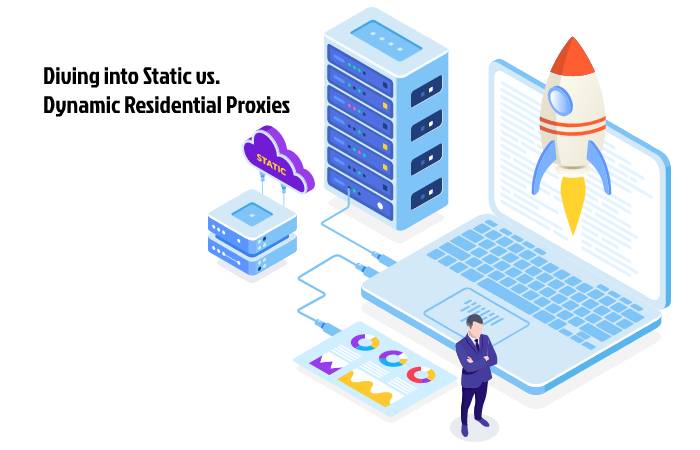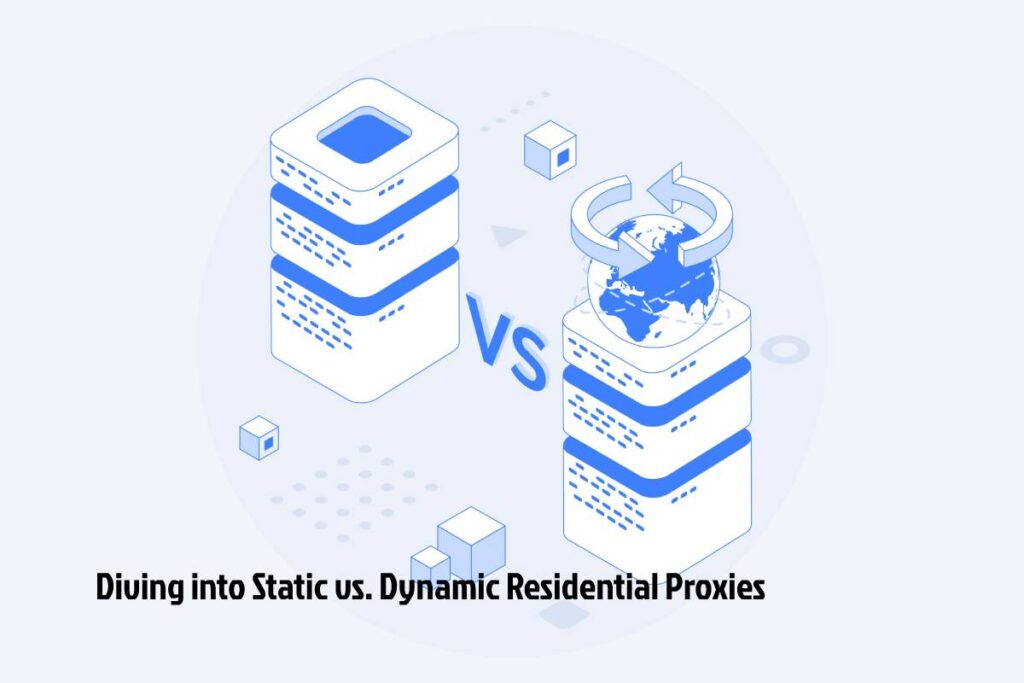Diving into Static vs. Dynamic Residential Proxies with the growing usage of online privacy tools, such as proxies, the number of different types of these solutions is also growing. Now, we have many ways to classify proxies, choosing features, IP types, or use cases as the basis for distinguishing.
However, the central categorizations of proxies remain those between static and dynamic and between data center and residential proxies. Here, we will look closer at static residential proxies and rotating or dynamic residential proxies. Comparing static vs. dynamic residential proxies will reveal which and when one should use to get the best results.
The tree of proxies
Proxies are middle servers between the client device and the end server. The client device is, for example, your laptop or cell phone. The end server is the host server for the website you are trying to visit.
The proxy, in this case, is the in-between server where your request goes before reaching the website and where the website’s response goes before coming back to your device. Such rerouting hides your IP address behind the IP assigned to you by the proxy server.
This fundamental way of operating applies to all proxies. One can then imagine the categorization of proxies as a tree-like structure. Branches of different proxies grow from this standard stem. The first branching separates proxies by their IP type.
Proxy IP types
Three major proxy IP types are distinguished by where the IP addresses are hosted. These are residential proxies, data center proxies, and mobile proxies.
Residential proxies

Internet service providers (ISPs) assign internet protocol (IP) addresses to all residencies that choose them as the provider. Thus, these IP addresses are called residential IPs. Residential proxies are the proxy services that provide users with this residential IP address.
Residential IPs have many benefits, including that this type of proxy is virtually undetectable. The website will usually not know that you are using a proxy and will consider and assume that a user from the associated residence is connecting.
Datacenter proxies
Data centers worldwide are home to powerful servers that host thousands of IP addresses. These IP addresses are not associated with any ISP. Proxies that assign users an IP address supported by such a server are known as datacenter proxies.
Datacenter proxies are often fast and cheap. Users have various selections from the IP addresses hosted in different geographic locations.
Mobile proxies
Mobile carriers assign their own IP addresses that differ from those given to homeowners or generated by data centers. These IP addresses are assigned to devices when they are using mobile data. Subscribing to a mobile proxy service will provide you with such an IP address.
Mobile proxies are more exclusive, often with less traffic going through them, and thus demonstrate exceptional performance. This type of proxy server is still relatively rare compared to the other two types.
Proxy rotation types
Another primary branching out of the proxy services is based on the proxy rotation type. In this sense, we have the division between static and rotating (or dynamic) proxies.
Sticky proxies are sometimes distinguished as those capable of short-period sticky sessions. However, since other proxy types can also be configured for sticky sessions, such additional differentiation is of doubtful utility.
Static proxies
Static proxies are proxy servers that do not rotate IP addresses. They assign one IP address that stays with you for the entire online session. Usually, you can keep your static proxy IP address for prolonged periods, such as days, or keep it until you manually disconnect from the proxy. The precise configurations depend on your agreement with your proxy service provider.
Dynamic proxies
Rotating or dynamic proxies are the proxy servers that automatically turn your assigned proxy IP addresses. The rotation can be set to happen after various periods, for example, every 30 minutes, every 2 hours, or every seven days. Proxies can also rotate with every new request made to the end server. It all depends on your proxy service plan and chosen settings.
Static vs. dynamic residential proxies: a comparison

Residential proxies are more common than mobile ones and issued by actual ISPs. Therefore, they can be considered the standard for all proxies. Thus, although all proxy types can branch out to static and dynamic proxies, below, we will concentrate on static vs. dynamic residential proxies.
Below are the significant things you should know when choosing between static and rotating residential proxy plans.
Static residential proxies
Static residential proxies provide a residential IP address that sticks to your device for a prolonged time. If you subscribe to the service and do not change the proxy yourself, you could stick to the same residential IP address.
This functionality is perfect for mimicking a single organic IP user. One might want to do that when managing social media accounts, streaming geo-blocked content, or copping sneakers. Static residential proxies are fast and reliable.
Dynamic residential proxies
Dynamic residential proxies automatically rotate the residential IPs you are using. Thus, your connection is jumping from one virtual residence to another. You gain even more anonymity by covering your tracks in this way.
This type of proxy rotation is excellent for web scraping and other activities requiring multiple requests to the same server. As your IP constantly rotates, it is less likely to be banned or throttled due to exceeding request caps. Even if one residential IP in the pool is forbidden, the rotation will ensure the continuation of the procedure.
In a nutshell
Choosing static vs. dynamic proxies depends on what you will use the proxy service for. Dynamic proxies are a bit slower due to jumping between IPs but are also less detectable. Thus, for large-scale web data extraction projects, you might want to choose this type of proxy.
Meanwhile, static proxies are better suited for cases requiring a stable IP connection, such as accessing specific content for a prolonged time or online shopping.


